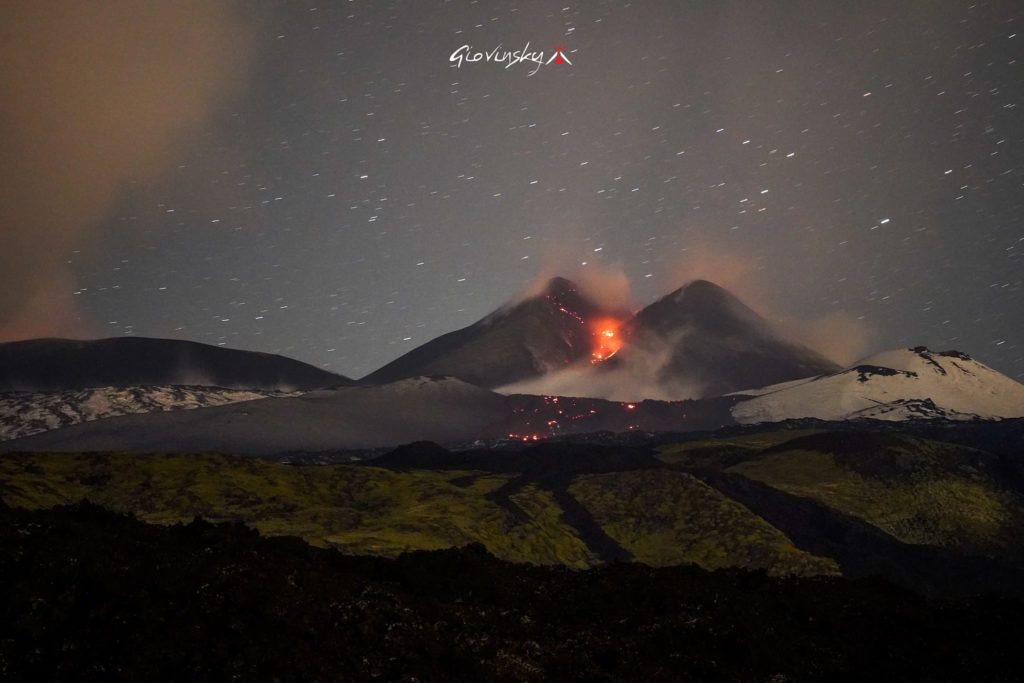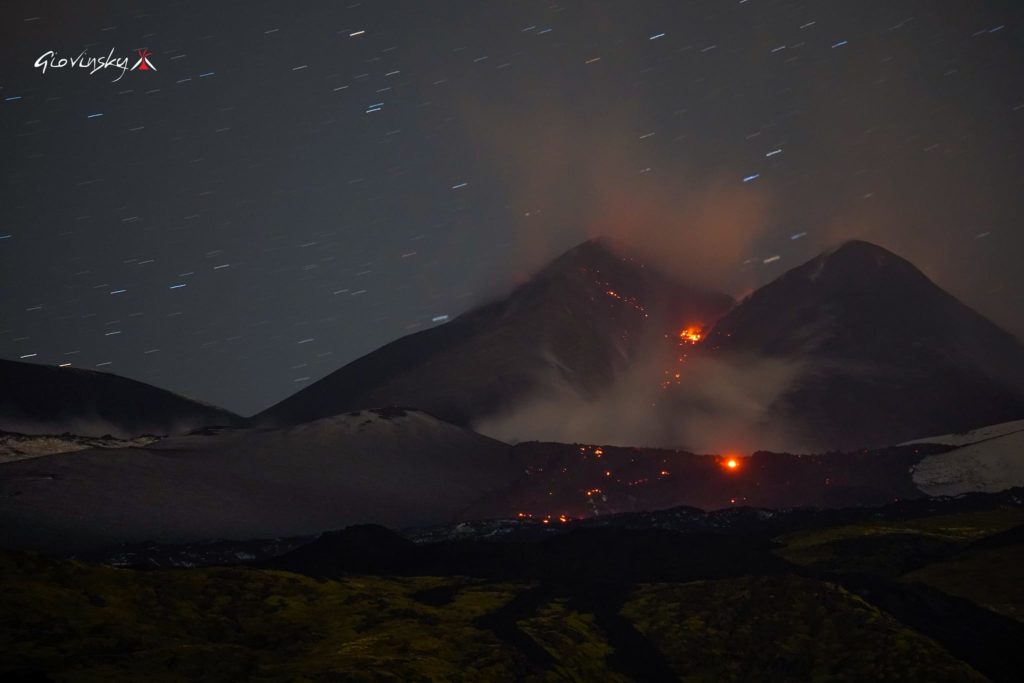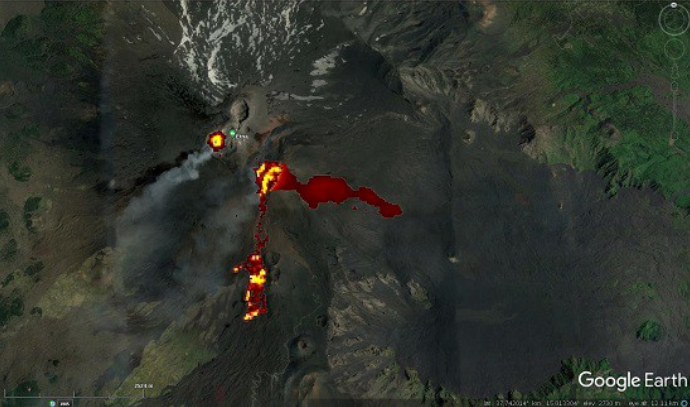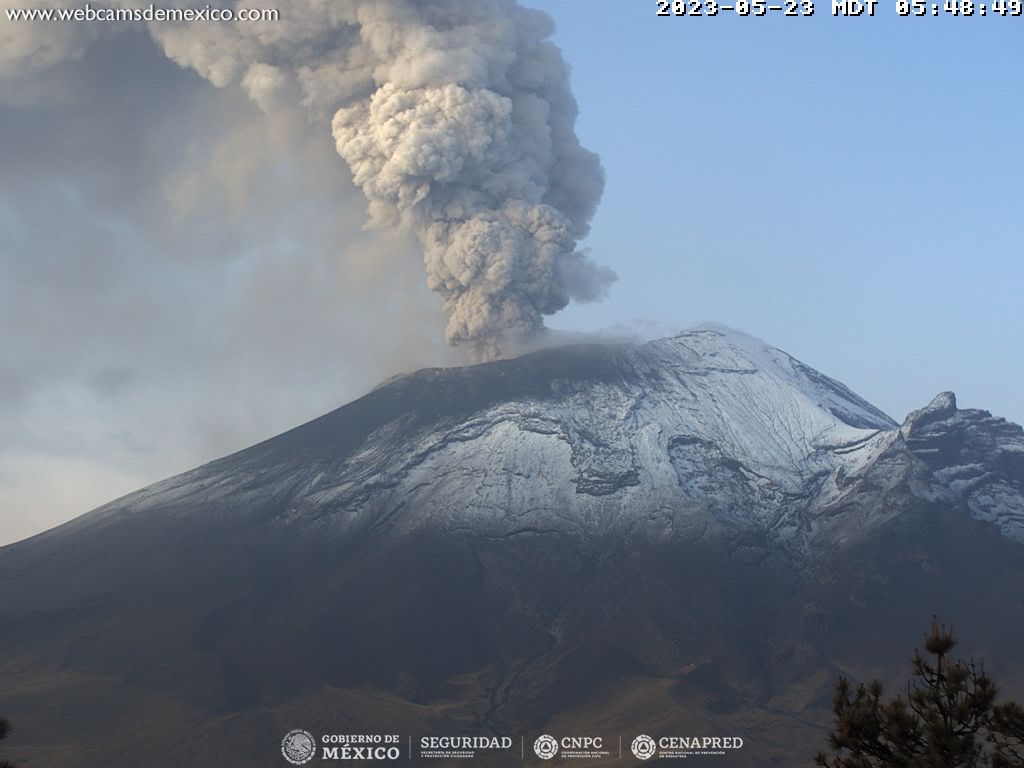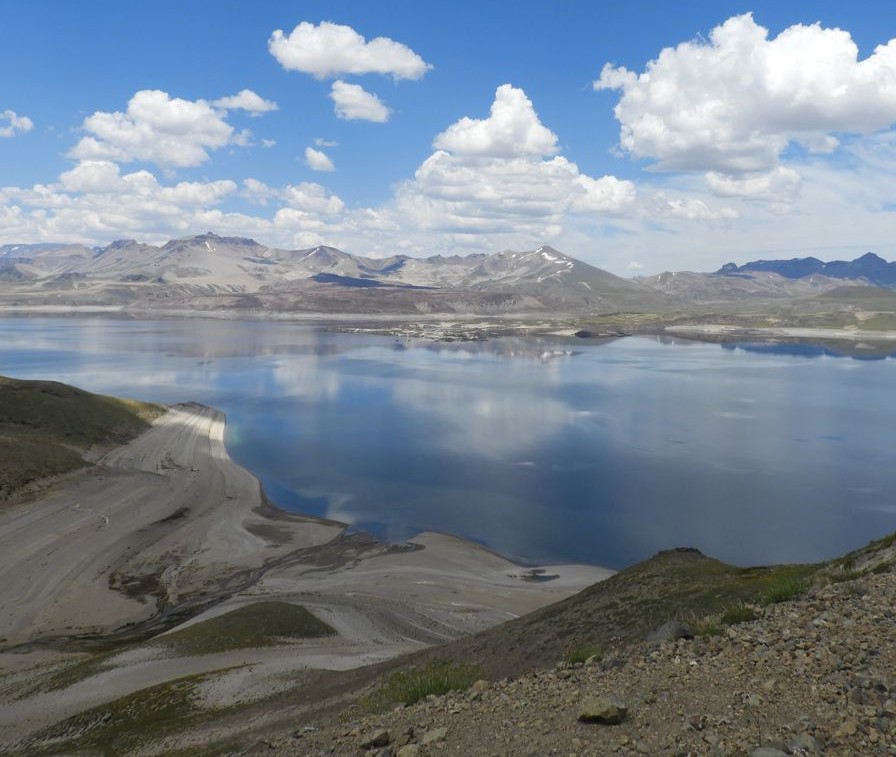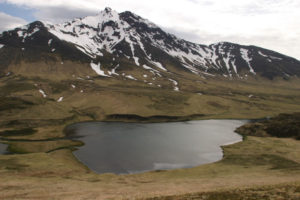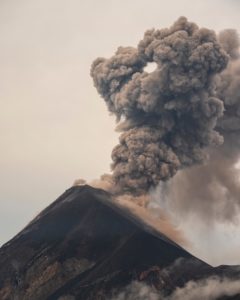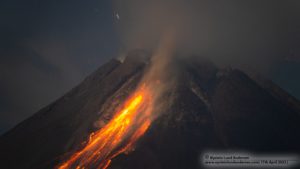May 24 , 2023.
Italy / Sicily , Etna :
Communique on the activity of Etna, May 23, 2023, 08:34 (06:34 UTC).
The National Institute of Geophysics and Volcanology, Osservatorio Etneo, communicates that the monitoring networks recorded at 08:32 (06:32 UTC), the end of volcanic activity.
From the analysis of the images of the video surveillance network, it is observed that the lava flows coming from the Southeast crater are cooling.
Further updates will be communicated soon.
WEEKLY BULLETIN, from May 15, 2023 to May 21, 2023 (issue date May 23, 2023)
ACTIVITY STATUS SUMMARY
In the light of the monitoring data, it is highlighted:
1) VOLCANOLOGICAL OBSERVATIONS: Degassing activity of the summit craters, in particular continuous degassing at the Bocca Nuova crater (BN) and at the Southeast crater (SEC). Between the 18th and the 19th, the eruptive activity resumed, with Strombolian activity at Bocca Nuova and the Southeast crater and ended with a paroxysm at the Southeast crater on the 21st with the establishment of flows of lava.
2) SEISMOLOGY: moderate seismic activity due to fracturing; Swarm in the summit zone on the 18th: The amplitude of the volcanic tremor reached high levels on the 18th in correspondence with the Strombolian activity and very high on the 21st in correspondence with the paroxysm at the Southeast Crater.
3) INFRASOUND: Increase in infrasound activity in correspondence with the paroxysm of May 21.
4) GROUND DEFORMATIONS: During the past week, the ground deformation monitoring networks have recorded variations during the volcanic activity of May 18 and 21 at the inclinometer stations of the summit zone and at the deformation measurement stations . The variations of May 18 are compatible with a rise of magma which would also generate a small intrusion, the variations of May 21 are those characteristic of a lava fountain event.
5) GEOCHEMISTRY: SO2 flux at a high level
CO2 fluxes are at medium-high outgassing values
The isotopic ratio of Helium is at medium-high levels.
The partial pressure of dissolved CO2 does not show significant variations
6) SATELLITE OBSERVATIONS: The thermal activity observed by satellite was moderate in correspondence with the eruptive activity in the summit zone. However, the bad weather conditions strongly affected the analysis of the satellite images.
7) OTHER OBSERVATIONS: The composition of the volcanic glass that was emitted during the May 21, 2023 lava fountain suggests that likely the magma that produced the fountain was the result of a small portion of primitive magma that mixed with the magma that was parked in the « reservoir » (magma chamber).
VOLCANOLOGICAL OBSERVATIONS
The monitoring of Etna’s volcanic activity was carried out through the analysis of images acquired by the network of INGV surveillance cameras, Osservatorio Etneo (INGV-OE) and through
field inspections by INGV-OE staff. For most of the week, although weather conditions prevented systematic observation of activity at the summit craters, short intervals of visibility allowed observation of eruptive activity at Bocca. Nuova and Southeast Craters.
In particular, on the 18th, through images from the Bronte thermal camera, explosive activity was observed at the Bocca Nuova crater from 15:00 UTC. Although there is uncertainty due to weather conditions, it is likely that this activity continued in the following hours, as detected by satellite images.
Satellite image of the lava field by Landsat 8 at 8:45 p.m. GMT on May 22, 2023 (spatial resolution of 30m to 100m)
On the same day at around 2:56 UTC, weak intra-crater Strombolian activity was recorded using the INGV cameras located on Montagnola. Also in this case, it is likely that this modest explosive activity between 7:00 p.m. and 8:00 p.m. was intermittent and not continuous, but on May 21, the modest and episodic explosive activity of the Southeast crater, which already from May 8 to May 14 had showed weak explosions, suddenly evolves into a lava fountain. The event begins at approximately 05:30 UTC and ends at 09:40 UTC. As typical of lava fountain phenomena, the phenomenon creates a plume that extends up to about 10 km (satellite data) and with ash fallout on the Southwest slope (eg, Adrano) and thereafter due to the slow change in direction of the winds, from the South sector (eg Catania) to the South-East sector (eg Aci Castello).
Communique on the activity of Etna, May 24, 2023, 02:05 (00:05 UTC).
The National Institute of Geophysics and Volcanology, Osservatorio Etneo, communicates that the monitoring networks recorded at 01:53 (23:53 UTC), a weak Strombolian activity at the level of the Southeast crater. Lightning is also visible at the Voragine crater.
The simulation of the possible dispersion of the volcanic cloud indicates a North-East direction.
During the last two hours, the average amplitude of volcanic tremors tends to increase and currently reaches almost the high level. The source of the volcanic tremor affects the area of the Southeast crater, at an altitude of about 2800 m above sea level. The infrasonic activity is rather modest. Infrasonic events are mainly located at the Bocca Nuova and Voragine craters, a few events also affect the Southeast crater.
The signals from the inclinometer and GNSS networks do not show any significant variations.
Further updates will be communicated soon.
Source : INGV.
Photo : Giovinsky Sicilia , Landsat 8 / INGV.
Italy , Stromboli :
WEEKLY BULLETIN, from May 15, 2023 to May 21, 2023 (issue date May 23, 2023)
ACTIVITY STATUS SUMMARY
In the light of the monitoring data, it is highlighted:
1) VOLCANOLOGICAL OBSERVATIONS: Normal Strombolian activity was observed during this period. The total hourly frequency fluctuated between average values (6-12 events/h) with a downward trend. The intensity of the explosions was mainly weak in the North crater zone and medium in the Center-South crater zone.
2) SEISMOLOGY: The seismological parameters monitored do not show any significant variations.
3) SOIL DEFORMATIONS: The island’s soil deformation monitoring networks did not show any significant variations to report for the period considered.
4) GEOCHEMISTRY: the flow of SO2 is at an average level
There are no CO2 flux data updates.
There are no C/S data updates.
There are no updates on the R/Ra ratio.
5) SATELLITE OBSERVATIONS: The thermal activity observed from the satellite was generally weak.
VOLCANOLOGICAL OBSERVATIONS
During the observation period, the eruptive activity of Stromboli was characterized thanks to the analysis of the images recorded by the surveillance cameras of the INGV-OE at an altitude of 190m (SCT-SCV) and of the Pizzo sopra la Fossa (SPT). The explosive activity was mainly produced by 2 (two) eruptive vents located in the North zone of the crater and by 3 (three) vents located in the Center-South zone.
Due to the unfavorable weather conditions from May 15 to 16, 17, the visibility of the crater area was insufficient for a correct description of the eruptive activity.
Observations of explosive activity captured by surveillance cameras
In the area of the North crater (N), characterized by a vent located in the N1 sector and one in the N2 sector, a low intensity explosive activity was observed (the erupted products reached a height of less than 80 m) in both sectors. The products ejected are mainly coarse materials (bombs and lapilli) in sector N2 and fine materials (ash) in sector N1. The average frequency of explosions in the North zone fluctuates between 1 and 7 events/h.
In the Center-South zone (CS), the S2 sector, characterized by two active vents, mainly showed explosive activity of medium intensity with emission of coarse materials mixed with fine materials. Sectors S1 and C did not show significant eruptive activity. The average frequency of explosions in the Center-South zone is almost constant with 5 events/h.
Source : INGV.
Photo : Stromboli stati d’animo
Mexico , Popocatepetl :
May 23, 11:00 a.m. (May 23, 5:00 p.m. GMT)
During the last 24 hours, according to the monitoring systems of the Popocatépetl volcano, 22 exhalations accompanied by water vapor, volcanic gases and ash have been detected. In addition, 1,234 minutes of low to large amplitude high frequency tremors were recorded, associated with the continuous emission of gas, water vapor and ash, as well as occasions for the expulsion of incandescent material. a short distance from the volcano.
CENACOM (National Center for Communication and Civil Protection Operations) reported during this period ash falls in the municipalities of Nealtican, Tianguismanalco, Atlixco, San Diego la Mesa, Huaquechula and Atzizihuacán, state of Puebla.
At the time of this report, there is no visibility towards the volcano due to weather conditions in the area. However, a constant emission of water vapor, volcanic gases and slight amounts of ash was observed in a northeasterly direction.
May 23, 7:00 p.m. (May 24, 01:00 GMT)
Update.
The recording of tremors continues with a moderate to low amplitude. The prevailing weather conditions in the region do not allow visibility towards the volcano, however an emission of steam and gas with low ash content has sometimes been observed. Any changes in activity will be reported in a timely manner.
CENAPRED insistently reiterates the recommendation NOT TO CLIMB to the crater of the volcano, because there is the possibility of explosions, as has been seen on several occasions in the past, involving the emission of incandescent fragments. Therefore, he is required to respect the exclusion radius of 12 km. Also, in heavy rain, stay away from the bottom of ravines due to the danger of mudslides and debris.
In accordance with what was declared by the National Civil Protection Coordination during the press conference held on May 21 at CENAPRED, the Popocatépetl volcanic alert traffic light is in YELLOW PHASE 3.
Source : Cenapred.
Chile , Laguna del Maule :
Seismology
The seismological activity of the period was characterized by the recording of:
3690 VT type seismic events, associated with rock fracturing (Volcano-Tectonics). The most energetic earthquake presented a value of local magnitude (ML) equal to 1.8, located 10.5 km west-southwest of the center of the lagoon, at a depth of 9.7 km compared to the average height of the lagoon.
2 LP-type seismic events, associated with fluid dynamics within the volcanic system (Long Period type). The size of the largest earthquake assessed from the Reduced Displacement (DR) parameter was equal to 4 cm2.
Fluid Geochemistry
No anomalies in sulfur dioxide (SO2) emissions into the atmosphere have been reported in the area near the volcanic complex, according to data published by the Tropospheric Monitoring Instrument (TROPOMI) and the Ozone Monitoring Instrument (OMI) Sulfur Dioxide Group.
Geodesy
The geodetic activity of the period was characterized by:
Slight decrease in the elongation rates of 2 monitoring lines, this is linked to a greater displacement of the MAU2 and NIEB stations towards the North, but they continue in an inflationary process and their rates are within the usual parameters of deformation of the volcanic complex .
Changes in the deformation rates of the NIEB station, becoming the station with the greatest deformation, both vertically and horizontally, a change coinciding with the greatest seismicity of the last periods which are located closest to this station.
Rates and trends, of other monitoring stations, similar to previous periods and which show a permanent deformation (inflation) since the year 2012 (since the installation of the geodetic network) and which has been maintained until now.
Stability at inclinometer stations.
Evidence of historical distortion observed in interferograms that coincides in location and magnitude with that observed by the GNSS network.
Possible migration of the deformation source from the MAU2 station to the NIEB station (preliminary results).
Satellite geomorphological analysis
Based on the analysis of Sentinel 2-L2A and Planet Scope satellite images, no morphological changes were identified during the assessed period, in the area of the volcanic complex.
The VT seismic activity record persists, mainly located towards the Southwest sector, although with less recurrence than the previous periods. The deformation process remains crustal with high flows, maintaining a slight modification in its behavior, linked to an increase in vertical movements at the Nieblas station. In turn, no superficial changes are observed.
That said, it is considered that activity levels are still above their baseline threshold, maintaining the technical alert in yellow and a possible 2 km radius of assignment measured from the source of the anomaly. of CO2 detected.
YELLOW TECHNICAL ALERT: Changes in volcanic activity behavior
Source : Sernageomin.
Photo : Cegemar.
Colombia , Nevado del Ruiz :
Manizales, May 23, 2023 10:40 a.m.
Regarding the monitoring of the activity of the NEVADO DEL RUIZ VOLCANO, the MINISTRY OF MINES AND ENERGY through the COLOMBIAN GEOLOGICAL SERVICE (SGC) informs that:
From 09:00 yesterday (May 22) until the time of publication of this bulletin, the seismic activity related to the movement of fluids inside the volcanic conduits presented an increase in the number of earthquakes and continued to show seismic energy levels released similar to those of the day before (May 21). Some of the seismic signals were associated with pulsating ash emissions confirmed by web cameras used for volcanic monitoring.
On the other hand, the seismicity associated with the fracturing of the rock inside the volcanic edifice increased in number of earthquakes and showed levels of seismic energy released similar to those of the previous day (21 May ). This seismicity was located in the northeast, north and south sectors of the volcano and in the Arenas crater, at a maximum distance of 6 km from it and at depths between 1 and 7 km.
Regarding the surface activity, the maximum height of the column of gas and / or ash was 1300 m measured from the summit of the volcano and it presented a preferential direction of dispersion towards the North-East. Variations in the outgassing of sulfur dioxide and the release of water vapor from the crater into the atmosphere continue.
The level of activity of the volcano remains at the ORANGE LEVEL of activity or (II): PROBABLE ERUPTION IN TERM OF DAYS OR WEEKS.
Source et photo : SGC


